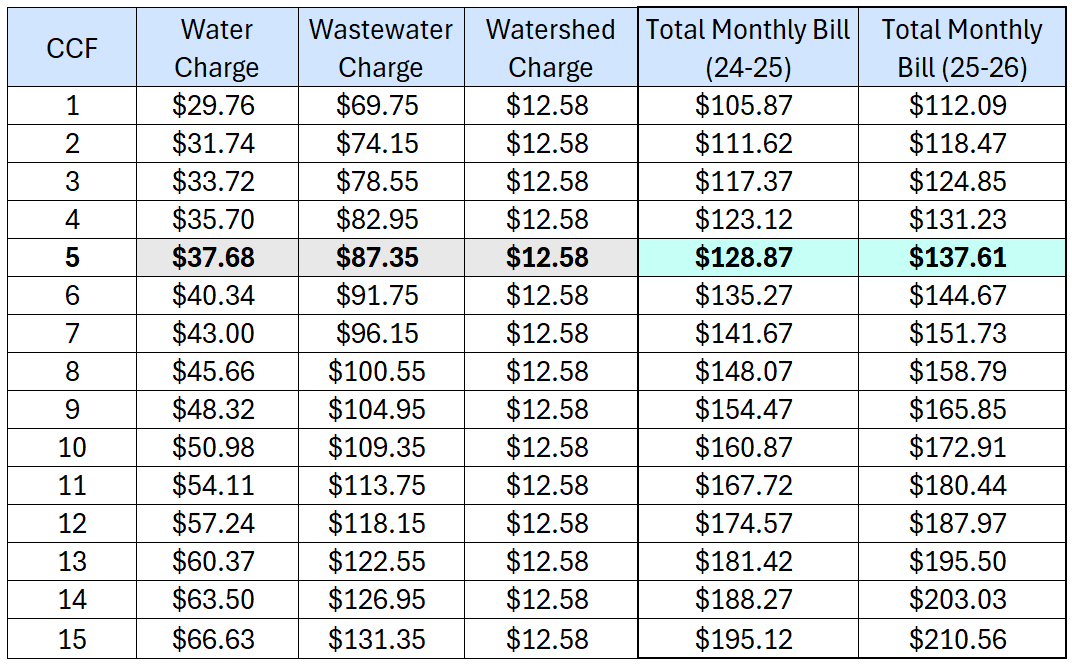Upcoming Rate Changes
New Rates Go Into Effect July 1, 2025
Oak Lodge Water Services (OLWS) updates its rates, fees, and charges on July 1 each year. Rates are determined through a months-long budgeting process with the goal of providing high-quality, reliable service at a reasonable cost to customers.
For the average customer* who receives all three services from Oak Lodge (water, wastewater, and watershed protection), you can expect your bill to increase by about $9/month starting in July 2025.
The fee schedule is reviewed by the Budget Committee, which is comprised of members of the public and Board members, and then approved by the elected Board of Directors.
How Much Are Rates Increasing?
The 2025-2026 charge for each service (the base rate plus consumption) is shown below, along with the total monthly bill compared to last year's. Centum Cubic Feet (CCF) is the measure of water consumption. 1 CCF is equal to 100 cubic feet or roughly 748 gallons. The average usage in our district is 5 CCF per month (highlighted in the table).
To find your average water usage, refer to your last few billing statements or call us at (503) 654-7765.

How Will This Impact My Bill?
For the average customer* who receives all three services from Oak Lodge (water, wastewater, and watershed protection), your bill will increase by about $8.74/month.
For the average water-only customer*, your bill will increase by about $2.25/month.
*Based on our district's average consumption of 5 CCF per month.
Please note that your bill with vary based on your unique usage; learn how to read your bill. If you have questions, please call us at (503) 654-7765.
What Changed In This Year's Budget?
The budget for the upcoming fiscal year is focused on maintaining the current level of service, while also investing in much-needed infrastructure improvements. Capital expenditures have been increased to address our aging infrastructure and make necessary system improvements. The aim of these improvements is to uphold service reliability and ensure compliance with local and federal regulations.
To learn more about what infrastructure improvements we're working on, you can review our Capital Improvement Plan or take a look through our active projects.
What's Driving the Increase?
.png?ixlib=rb-1.1.0&w=2000&h=2000&fit=max&or=0&s=209c0ab4ac4877b7dc590e968e387834)
- Aging Infrastructure
- Infrastructure improvements (outlined in our Capital Improvement Plan) are necessary to continue safely and reliably delivering service to our customers.
- New Regulations
- For example, OLWS' National Pollutant Discharge Elimination System (NPDES) permit, which allows us to discharge clean water from our wastewater treatment plant into the Willamette, now includes new, more stringent requirements. To meet them and avoid costly fines, we need to build another level of filtration.
- Higher Energy & Material Costs
- Electricity is a main driver at approximately a 40% increase since 2021. Other utilities have had smaller but significant increases.
- Community Stewardship
- Updating old infrastructure now prevents existing issues from worsening and new problems from cropping up. Tackling problems now also helps control long-term costs.
Why Does Our Infrastructure Need Updating?
Much of OLWS' water and wastewater pipes are approaching the end of their useful life. The majority of our systems were constructed in the early 1960s and are reaching the end of their roughly 75-year service life.

Our goal is to invest in infrastructure at the best time to maintain current service levels. Ideally, pipes should be replaced at the end of their "service life," when replacement or rehabilitation is less expensive than regular breaks and emergency repairs. Ultimately, neglecting or delaying infrastructure improvements in the short-term makes the community's future infrastructure challenges costlier.
What Happens If You Delay Infrastructure Updates?
Delaying infrastructure investment can result in:
- Degraded water and wastewater service
- Increased service disruptions
- Increased sanitary sewer overflows (SSOs)
- Increased expenditures for emergency repairs
Much like when a house's roof begins to fail, the potential damage to the rest of the house increases if repairs and replacements are delayed. Our goal is to proactively address these issues before any service degradation or interruption occurs.
What Are You Doing to Fund Improvements While Controlling Rates?
- Using cost-effective methods when repairing and replacing infrastructure
- For example, we've implemented a less costly and invasive pipe replacement method where possible.
- In a method called "pipe bursting," a tool breaks the damaged pipe apart while it's still in the ground and pulls a new one into place behind it. This is often less costly than traditional methods like open trench replacement.
- For example, we've implemented a less costly and invasive pipe replacement method where possible.
- Pursuing additional funding sources
- OLWS has been intensively pursuing additional funding partnerships for its tertiary treatment facility and implementing its inflow and infiltration remedy plan.
- This year, in partnership with Thorn Run Partners, OLWS secured $3,000,000 in state funding to help offset the costs of building a tertiary treatment facility.
- OLWS has been intensively pursuing additional funding partnerships for its tertiary treatment facility and implementing its inflow and infiltration remedy plan.
 Contact Us
Contact Us